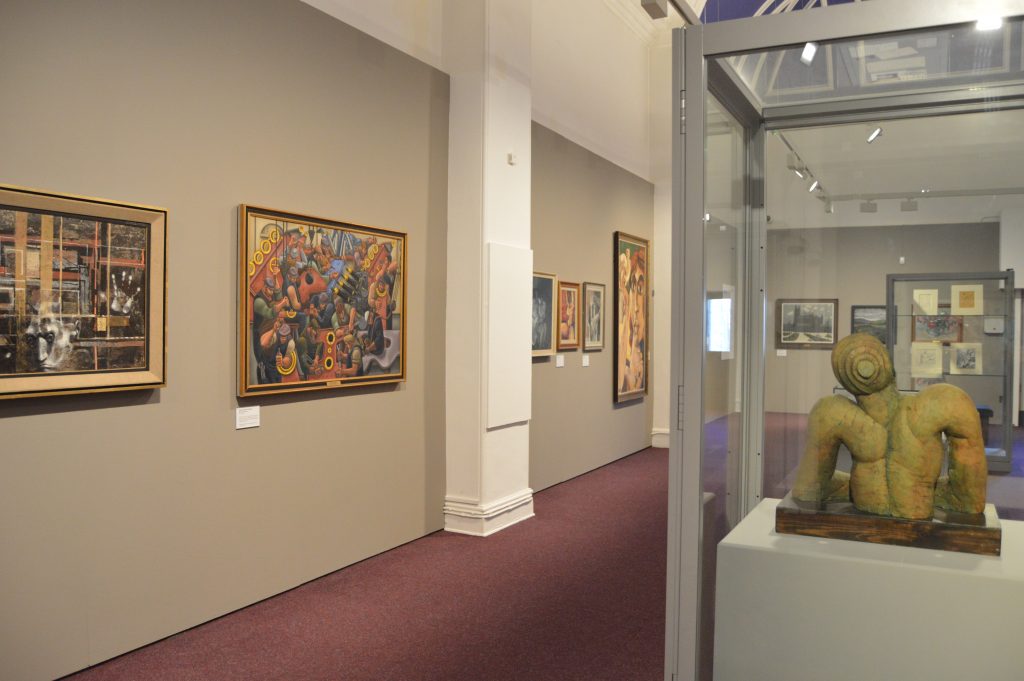
Three famous Salford artists feature in the latest “Exploring the Collection” exhibition at Salford Museum and Art Gallery.
It experimental, surreal, and traditional paintings by L S Lowry, Harold Riley and Geoffrey Key that provide an artistic perspective to local demolished buildings, historical settings, the human mind, and the body. Even if some pieces are too bleak to sympathise, there is always a canvas that catches the eye.
 Exploring the Collection at the Salford Museum and Art Gallery. Credit: Mel Cionco
Exploring the Collection at the Salford Museum and Art Gallery. Credit: Mel Cionco
Work from the trio features alongside multiple works by other 20th century British artists – diversifying the perspective of what is like to have lived in Salford, either through picturing buildings, its people, or the working class.

The entire exhibition’s ambition to highlight all artists and their own unique contributions does not shy away from getting its main artists to feature their influential as well as provocative works. This shines mostly with Geoffrey Key’s European Modernism. His nude sculptures and stylised oil paintings steal the show, showing the extent to which face exaggeration can go for as well as a modern acceptance of the body and the expertise of animal anatomy.

This contrasts with other pieces and paintings, that feature buildings with washed down black and brown colours be left unnoticed. Even more if they just feature the illustrations of buildings and streets. This is the case with Harold Riley’s and LS Lowry’s works, with watercolours and oil, only consists of these gloomy depictions of streets and buildings. Similar or not, it gives balance cojoined with other displays, as well as giving insight to how the artists depicted the city of Salford as overtaken by bleak weather and ever pressing recessions.

However, these paintings are few and far in-between, the rest of the exhibition although also showcasing infrastructures like churches and community centres, selected more stylised and colourful pieces. Anthony’s McCarthy paintings depicting busy streets in a palette of whites, reds, and yellows, successfully breaks walls away from only becoming displays of only depressive greys and browns.

Some paintings are not even from the main three featured artists, yet they still can cover entire walls from how they stand out outside of the other paintings. Works like William Robert’s “Munition Factory”, a piece commissioned by the Ministry of Information in 1940, can grab further appeal by their use of simple shapes, bold colour palettes, and historical context. The piece sees multiple workers helping on the manufacturing of what be interpreted as bullets or simple infrastructure. The piece uses basic shapes turned that piece together to become humans which puzzle to never overlap each other, and its colourful backgrounds would make it my favourite piece of the collection.

The highlight needs to be Michael Ayrton’s “Smoke Haye Head”, a piece that just highlights the surrealistic imagination of its painter, and in the words of Geoffrey Key shows Ayrton as “one of the country’s true surrealists”. The piece catches you by surprise when you least expect it, a simple canvas made from coloured square outlines, all surrounding a figure’s cold gaze.

The exhibition is excellent at showing the historical talent Salford hosted within its streets once. It collects a diverse selection of what art can represent, from illustrations, to oil paintings, watercolours, and sculptures. Thanks to its free entry, anyone can come and enjoy this talent and its portrayal of the creative city Salford represents.
The exhibition will be on until Sunday 30 April 2023.














Recent Comments